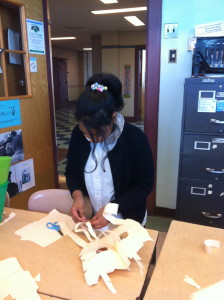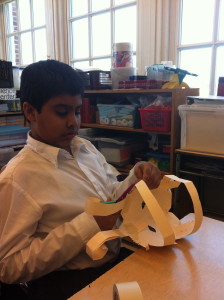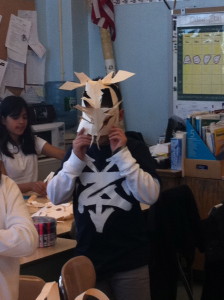Case Study 1: Exploring the West African Mask: Creating Unique Interpretations of a Ceremonial Object.


 Project Overview: Students investigated traditions of West African masquerade. Looking at mask forms and practices from Benin, Mali, Burkina Fasso, Côte d’Ivoire, and Nigeria, students learned about the traditions of masquerade and mask making in each of these places. The teaching artist and teachers connected these traditions to wider cultural, religious, and environmental and historical ideas in West Africa. Taking a cue from the Metropolitan Museum of Art exhibit, “Reconfiguring an African Icon: Odes to the Mask by Modern and Contemporary Artists from Three Continents,” students created their own unique “interpretations” of a West African mask, adding in shapes, designs, objects, and uses for their masks that reflect their own everyday realities, rituals, and traditions.
Project Overview: Students investigated traditions of West African masquerade. Looking at mask forms and practices from Benin, Mali, Burkina Fasso, Côte d’Ivoire, and Nigeria, students learned about the traditions of masquerade and mask making in each of these places. The teaching artist and teachers connected these traditions to wider cultural, religious, and environmental and historical ideas in West Africa. Taking a cue from the Metropolitan Museum of Art exhibit, “Reconfiguring an African Icon: Odes to the Mask by Modern and Contemporary Artists from Three Continents,” students created their own unique “interpretations” of a West African mask, adding in shapes, designs, objects, and uses for their masks that reflect their own everyday realities, rituals, and traditions.
Teaching artist Clara Wallof Discusses the Project
A recently arrived immigrant is interviewed about her experience
Classroom teacher Paul documented throughout his residency and put together a video about the process
Inquiry Questions:
- What is a mask? Why are they made and used?
- Where have you seen, touched, or worn a mask?
- What have these masks traditionally been used for?
- What is a ritual? What rituals do we have in our lives?
- What is a tradition? What traditions do we have in our lives?
- What place could these masks have in modern day Western Africa?
- How are some of them “reinterpreted?”
- What evidence do we see of that reinterpretation? (i.e. Jerrican masks use gasoline cans, Metropolitan Museum of Art exhibit used modern day materials)
- What materials could we each gather that would add to a mask about our everyday lives? About our rituals? Our traditions?
